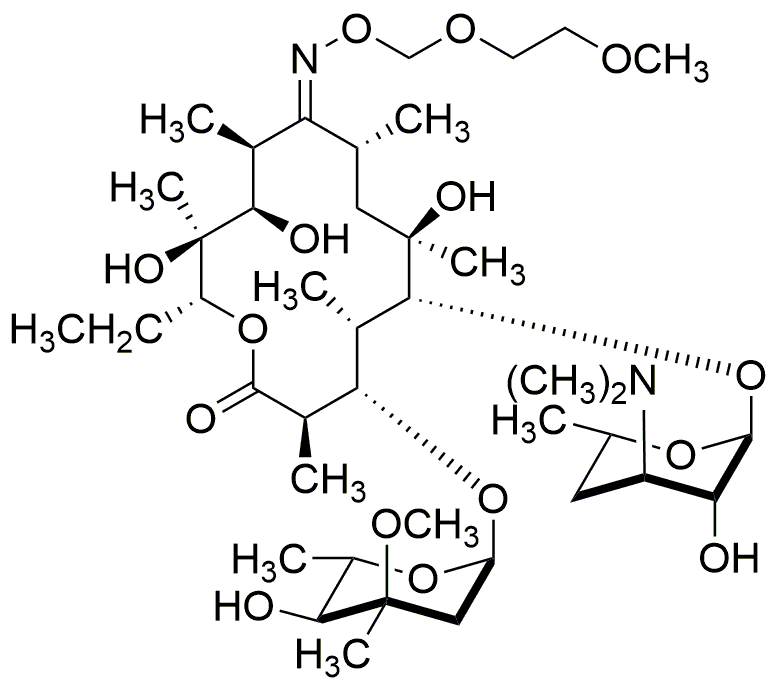Roxithromycin is widely utilized in research focused on:
- Antibiotic Therapy: This compound is primarily used to treat bacterial infections, particularly respiratory tract infections. Its effectiveness against a broad spectrum of bacteria makes it a preferred choice in clinical settings.
- Pharmaceutical Development: Roxithromycin serves as a model compound in the development of new macrolide antibiotics, allowing researchers to study structure-activity relationships and enhance drug efficacy.
- Veterinary Medicine: The compound is also applied in veterinary practices to treat infections in animals, ensuring their health and well-being, which is crucial for livestock and pets alike.
- Research on Drug Resistance: It is used in studies investigating antibiotic resistance mechanisms, helping scientists understand how bacteria adapt and develop resistance, which is vital for developing new treatments.
- Formulation Science: Roxithromycin is explored in various drug formulations, including extended-release and combination therapies, enhancing patient compliance and therapeutic outcomes.
General Information
Properties
Safety and Regulations
Applications
Roxithromycin is widely utilized in research focused on:
- Antibiotic Therapy: This compound is primarily used to treat bacterial infections, particularly respiratory tract infections. Its effectiveness against a broad spectrum of bacteria makes it a preferred choice in clinical settings.
- Pharmaceutical Development: Roxithromycin serves as a model compound in the development of new macrolide antibiotics, allowing researchers to study structure-activity relationships and enhance drug efficacy.
- Veterinary Medicine: The compound is also applied in veterinary practices to treat infections in animals, ensuring their health and well-being, which is crucial for livestock and pets alike.
- Research on Drug Resistance: It is used in studies investigating antibiotic resistance mechanisms, helping scientists understand how bacteria adapt and develop resistance, which is vital for developing new treatments.
- Formulation Science: Roxithromycin is explored in various drug formulations, including extended-release and combination therapies, enhancing patient compliance and therapeutic outcomes.
Documents
Safety Data Sheets (SDS)
The SDS provides comprehensive safety information on handling, storage, and disposal of the product.
Product Specification (PS)
The PS provides a comprehensive breakdown of the product’s properties, including chemical composition, physical state, purity, and storage requirements. It also details acceptable quality ranges and the product's intended applications.
Certificates of Analysis (COA)
Search for Certificates of Analysis (COA) by entering the products Lot Number. Lot and Batch Numbers can be found on a product’s label following the words ‘Lot’ or ‘Batch’.
Numéro de catalogue
Numéro de lot/série
Certificates Of Origin (COO)
This COO confirms the country where the product was manufactured, and also details the materials and components used in it and whether it is derived from natural, synthetic, or other specific sources. This certificate may be required for customs, trade, and regulatory compliance.
Numéro de catalogue
Numéro de lot/série
Safety Data Sheets (SDS)
The SDS provides comprehensive safety information on handling, storage, and disposal of the product.
DownloadProduct Specification (PS)
The PS provides a comprehensive breakdown of the product’s properties, including chemical composition, physical state, purity, and storage requirements. It also details acceptable quality ranges and the product's intended applications.
DownloadCertificates of Analysis (COA)
Search for Certificates of Analysis (COA) by entering the products Lot Number. Lot and Batch Numbers can be found on a product’s label following the words ‘Lot’ or ‘Batch’.
Numéro de catalogue
Numéro de lot/série
Certificates Of Origin (COO)
This COO confirms the country where the product was manufactured, and also details the materials and components used in it and whether it is derived from natural, synthetic, or other specific sources. This certificate may be required for customs, trade, and regulatory compliance.


